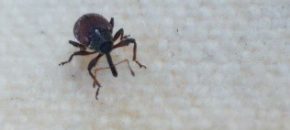Allium Leaf Miner Allium leaf miner (ALM) adults (flies) were trapped on sticky cards, and moderate levels of feeding signs were discovered late last week at sites in Lawrenceville and Pennington (Mercer County). Additionally, volunteer garlic in the Chesterfield area of Burlington County was infested. As yet, no adult activity or feeding has been found at the more northern […]
Continue reading...Tree Fruit IPM Report for April 27, 2018

Peach: Brown Rot: Blossom infections from the brown rot fungus can occur whenever pistils are exposed and a favorable climate exists. Infections can occur during any wetting period when temperatures are between 41 and 86 ° F. However optimum conditions for infection occur with wetting and temperatures in the mid 70’s. During long wetting periods […]
Continue reading...Peach Disease Control at Petal Fall, Shuck-Split, and Early Covers
Except for the fruit ripening stage, the petal fall (PF) through second cover (2C) stages on peach and nectarine constitute perhaps one of the most important periods for disease control. In addition to continued control of blossom blight at petal fall, three other diseases must be considered as well: rusty spot, scab, and bacterial spot. […]
Continue reading...Controlling Septoria Leaf Spot and Bacterial Leaf Blight in Parsley
Septoria leaf spot (SLS) in Parsley can cause significant losses in fields where it has become established. Like other Septoria’s, the leaf spots produced on parsley look much like the leaf spots produced on tomatoes and other crops. Septoria leaf spot overwinters from year to year on infected debris so long crop rotations of 2 […]
Continue reading...Damping-off: Identifying and Controlling Early-Season Pathogens
It is extremely important to know which pathogen is causing damping-off problems and which fungicide to properly apply. The key to controlling damping-off is being proactive instead of reactive. Always refer to the fungicide label for crop use, pathogens controlled, and application rates. Damping-off is caused by a number of important vegetable pathogens and is […]
Continue reading...Controlling Spring Diseases in Asparagus
Asparagus season is just around the corner and now is a good time to review important diseases. Wet soil conditions are ideal for Phytophthora and Pythium development. To help reduce potential losses, especially in fields with low spots or fields that are poorly drained soils, or more importantly, in fields with a history of either […]
Continue reading...